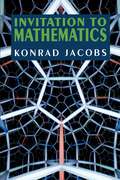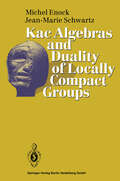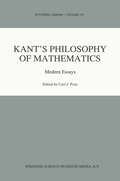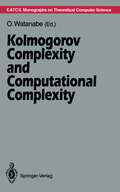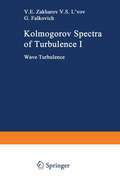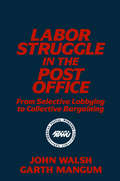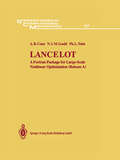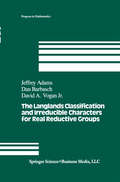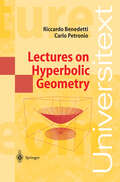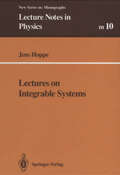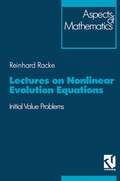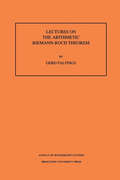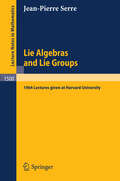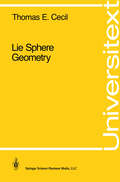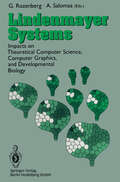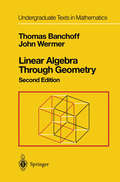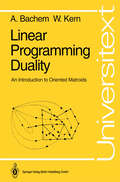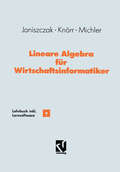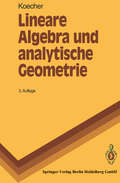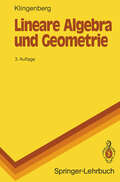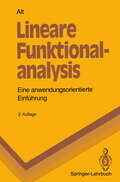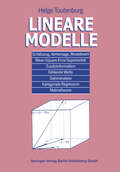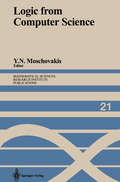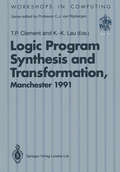- Table View
- List View
Invitation to Mathematics
by Konrad JacobsBased on a well-received course designed for philosophy students, this book is an informal introduction to mathematical thinking. The work will be rewarding not only for philosophers concerned with mathematical questions but also for serious amateur mathematicians with an interest in the "frontiers" as well as the foundations of mathematics. In what might be termed a sampler of the discipline, Konrad Jacobs discusses an unusually wide range of topics, including such items of contemporary interest as knot theory, optimization theory, and dynamical systems. Using Euclidean geometry and algebra to introduce the mathematical mode of thought, the author then turns to recent developments. In the process he offers what he calls a "Smithsonian of mathematical showpieces": the five Platonic Solids, the Mbius Strip, the Cantor Discontinuum, the Peano Curve, Reidemeister's Knot Table, the plane ornaments, Alexander's Horned Sphere, and Antoine's Necklace. The treatments of geometry and algebra are followed by a chapter on induction and one on optimization, game theory, and mathematical economics. The chapter on topology includes a discussion of topological spaces and continuous mappings, curves and knots, Euler's polyhedral formula for surfaces, and the fundamental group. The last chapter deals with dynamics and contains material on the Game of Life, circle rotation, Smale's "horseshoe," and stability and instability, among other topics.
Kac Algebras and Duality of Locally Compact Groups
by Michel Enock Jean-Marie SchwartzThis book deals with the theory of Kac algebras and their dual ity, elaborated independently by M. Enock and J . -M. Schwartz, and by G. !. Kac and L. !. Vajnermann in the seventies. The sub ject has now reached a state of maturity which fully justifies the publication of this book. Also, in recent times, the topic of "quantum groups" has become very fashionable and attracted the attention of more and more mathematicians and theoret ical physicists. One is still missing a good characterization of quantum groups among Hopf algebras, similar to the character ization of Lie groups among locally compact groups. It is thus extremely valuable to develop the general theory, as this book does, with emphasis on the analytical aspects of the subject instead of the purely algebraic ones. The original motivation of M. Enock and J. -M. Schwartz can be formulated as follows: while in the Pontrjagin duality theory of locally compact abelian groups a perfect symmetry exists between a group and its dual, this is no longer true in the various duality theorems of T. Tannaka, M. G. Krein, W. F. Stinespring . . . dealing with non abelian locally compact groups. The aim is then, in the line proposed by G. !. Kac in 1961 and M. Takesaki in 1972, to find a good category of Hopf algebras, containing the category of locally compact groups and fulfilling a perfect duality.
Kant’s Philosophy of Mathematics: Modern Essays (Synthese Library #219)
by Carl J. PosyKant's views about mathematics were controversial in his own time, and they have inspired or infuriated thinkers ever since. Though specific Kantian doctrines fell into disrepute earlier in this century, the past twenty-five years have seen a surge of interest in and respect for Kant's philosophy of mathematics among both Kant scholars and philosophers of mathematics. The present volume includes the classic papers from the 1960s and 1970s which spared this renaissance of interest, together with updated postscripts by their authors. It also includes the most important recent work on Kant's philosophy of mathematics. The essays bring to bear a wealth of detailed Kantian scholarship, together with powerful new interpretative tools drawn from modern mathematics, logic and philosophy. The cumulative effect of this collection upon the reader will be a deeper understanding of the centrality of mathematics in all aspects of Kant's thought and a renewed respect for the power of Kant's thinking about mathematics. The essays contained in this volume will set the agenda for further work on Kant's philosophy of mathematics for some time to come.
Kolmogorov Complexity and Computational Complexity (Monographs in Theoretical Computer Science. An EATCS Series)
by Osamu WatanabeThe mathematical theory of computation has given rise to two important ap proaches to the informal notion of "complexity": Kolmogorov complexity, usu ally a complexity measure for a single object such as a string, a sequence etc., measures the amount of information necessary to describe the object. Compu tational complexity, usually a complexity measure for a set of objects, measures the compuational resources necessary to recognize or produce elements of the set. The relation between these two complexity measures has been considered for more than two decades, and may interesting and deep observations have been obtained. In March 1990, the Symposium on Theory and Application of Minimal Length Encoding was held at Stanford University as a part of the AAAI 1990 Spring Symposium Series. Some sessions of the symposium were dedicated to Kolmogorov complexity and its relations to the computational complexity the ory, and excellent expository talks were given there. Feeling that, due to the importance of the material, some way should be found to share these talks with researchers in the computer science community, I asked the speakers of those sessions to write survey papers based on their talks in the symposium. In response, five speakers from the sessions contributed the papers which appear in this book.
Kolmogorov Spectra of Turbulence I: Wave Turbulence (Springer Series in Nonlinear Dynamics)
by Vladimir E. Zakharov Victor S. L'vov Gregory FalkovichSince the human organism is itself an open system, we are naturally curious about the behavior of other open systems with fluxes of matter, energy or information. Of the possible open systems, it is those endowed with many degrees of freedom and strongly deviating from equilibrium that are most challenging. A simple but very significant example of such a system is given by developed turbulence in a continuous medium, where we can discern astonishing features of universality. This two-volume monograph deals with the theory of turbulence viewed as a general physical phenomenon. In addition to vortex hydrodynamic turbulence, it considers various cases of wave turbulence in plasmas, magnets, atmosphere, ocean and space. A sound basis for discussion is provided by the concept of cascade turbulence with relay energy transfer over different scales and modes. We shall show how the initial cascade hypothesis turns into an elegant theory yielding the Kolmogorov spectra of turbulence as exact solutions. We shall describe the further development of the theory discussing stability prob lems and modes of Kolmogorov spectra formation, as well as their matching with sources and sinks. This volume is dedicated to developed wave turbulence in different media.
Labor Struggle in the Post Office: From Selective Lobbying to Collective Bargaining
by John Walsh Garth L. MangumUsing data from the 2000 Census, this collection examines the major demographic and employment trends in the rural Midwestern states with special attention to the issues that state and local policy makers must address in the near future.
Labor Struggle in the Post Office: From Selective Lobbying to Collective Bargaining (Labor And Human Resources)
by John Walsh Garth L. MangumUsing data from the 2000 Census, this collection examines the major demographic and employment trends in the rural Midwestern states with special attention to the issues that state and local policy makers must address in the near future.
Lancelot: A Fortran Package for Large-Scale Nonlinear Optimization (Release A) (Springer Series in Computational Mathematics #17)
by A.R. Conn G.I.M. Gould P.L. TointLANCELOT is a software package for solving large-scale nonlinear optimization problems. This book is our attempt to provide a coherent overview of the package and its use. This includes details of how one might present examples to the package, how the algorithm tries to solve these examples and various technical issues which may be useful to implementors of the software. We hope this book will be of use to both researchers and practitioners in nonlinear programming. Although the book is primarily concerned with a specific optimization package, the issues discussed have much wider implications for the design and im plementation of large-scale optimization algorithms. In particular, the book contains a proposal for a standard input format for large-scale optimization problems. This proposal is at the heart of the interface between a user's problem and the LANCE LOT optimization package. Furthermore, a large collection of over five hundred test ex amples has already been written in this format and will shortly be available to those who wish to use them. We would like to thank the many people and organizations who supported us in our enterprise. We first acknowledge the support provided by our employers, namely the the Facultes Universitaires Notre-Dame de la Paix (Namur, Belgium), Harwell Laboratory (UK), IBM Corporation (USA), Rutherford Appleton Laboratory (UK) and the University of Waterloo (Canada). We are grateful for the support we obtained from NSERC (Canada), NATO and AMOCO (UK).
The Langlands Classification and Irreducible Characters for Real Reductive Groups (Progress in Mathematics #104)
by J. Adams D. Barbasch D.A. VoganThis monograph explores the geometry of the local Langlands conjecture. The conjecture predicts a parametrizations of the irreducible representations of a reductive algebraic group over a local field in terms of the complex dual group and the Weil-Deligne group. For p-adic fields, this conjecture has not been proved; but it has been refined to a detailed collection of (conjectural) relationships between p-adic representation theory and geometry on the space of p-adic representation theory and geometry on the space of p-adic Langlands parameters. This book provides and introduction to some modern geometric methods in representation theory. It is addressed to graduate students and research workers in representation theory and in automorphic forms.
Lectures on Hyperbolic Geometry (Universitext)
by Riccardo Benedetti Carlo PetronioFocussing on the geometry of hyperbolic manifolds, the aim here is to provide an exposition of some fundamental results, while being as self-contained, complete, detailed and unified as possible. Following some classical material on the hyperbolic space and the Teichmüller space, the book centers on the two fundamental results: Mostow's rigidity theorem (including a complete proof, following Gromov and Thurston) and Margulis' lemma. These then form the basis for studying Chabauty and geometric topology; a unified exposition is given of Wang's theorem and the Jorgensen-Thurston theory; and much space is devoted to the 3D case: a complete and elementary proof of the hyperbolic surgery theorem, based on the representation of three manifolds as glued ideal tetrahedra.
Lectures on Integrable Systems (Lecture Notes in Physics Monographs #10)
by Jens HoppeMainly drawing on explicit examples, the author introduces the reader to themost recent techniques to study finite and infinite dynamical systems. Without any knowledge of differential geometry or lie groups theory the student can follow in a series of case studies the most recent developments. r-matrices for Calogero-Moser systems and Toda lattices are derived. Lax pairs for nontrivial infinite dimensionalsystems are constructed as limits of classical matrix algebras. The reader will find explanations of the approach to integrable field theories, to spectral transform methods and to solitons. New methods are proposed, thus helping students not only to understand established techniques but also to interest them in modern research on dynamical systems.
Lectures on Nonlinear Evolution Equations: Initial Value Problem (Aspects of Mathematics #19)
by Reinhard RackeThis book serves as an elementary, self contained introduction into some important aspects of the theory of global solutions to initial value problems for nonlinear evolution equations. The presentation is made using the classical method of continuation of local solutions with the help of a priori estimates obtained for small data.
Lectures on the Arithmetic Riemann-Roch Theorem. (AM-127), Volume 127
by Gerd FaltingsThe arithmetic Riemann-Roch Theorem has been shown recently by Bismut-Gillet-Soul. The proof mixes algebra, arithmetic, and analysis. The purpose of this book is to give a concise introduction to the necessary techniques, and to present a simplified and extended version of the proof. It should enable mathematicians with a background in arithmetic algebraic geometry to understand some basic techniques in the rapidly evolving field of Arakelov-theory.
Lie Algebras and Lie Groups: 1964 Lectures given at Harvard University (Lecture Notes in Mathematics #1500)
by Jean-Pierre SerreLie Sphere Geometry: With Applications to Submanifolds (Universitext)
by Thomas E. CecilLie Sphere Geometry provides a modern treatment of Lie's geometry of spheres, its recent applications and the study of Euclidean space. This book begins with Lie's construction of the space of spheres, including the fundamental notions of oriented contact, parabolic pencils of spheres and Lie sphere transformation. The link with Euclidean submanifold theory is established via the Legendre map. This provides a powerful framework for the study of submanifolds, especially those characterized by restrictions on their curvature spheres. Of particular interest are isoparametric, Dupin and taut submanifolds. These have recently been classified up to Lie sphere transformation in certain special cases through the introduction of natural Lie invariants. The author provides complete proofs of these classifications and indicates directions for further research and wider application of these methods.
Lindenmayer Systems: Impacts on Theoretical Computer Science, Computer Graphics, and Developmental Biology
by Grzegorz Rozenberg Arto SalomaaL systems are language-theoretic models for developmental biology. They wereintroduced in 1968 by Aristid Lindenmayer (1925-1989) and have proved to be among the most beautiful examples of interdisciplinary science, where work in one area induces fruitful ideas and results in other areas. L systemsare based on relational and set-theoretic concepts, which are more suitable for the discrete and combinatorial structures of biology than mathematical models based on calculus or statistics. L systems have stimulated new work not only in the realistic simulation of developing organisms but also in the theory of automata and formal languages, formal power series, computer graphics, and combinatorics of words. This book contains research papers by almost all leading authorities and by many of the most promising young researchers in the field. The 28 contributions are organized in sections on basic L systems, computer graphics, graph grammars and map L systems, biological aspects and models, and variations and generalizations of L systems. The introductory paper by Lindenmayer and J}rgensen was written for a wide audience and is accessible to the non-specialist reader. The volume documents the state of the art in the theory of L systems and their applications. It will interest researchers and advanced students in theoretical computer science and developmental biology as well as professionals in computer graphics.
Linear Algebra Through Geometry (Undergraduate Texts in Mathematics)
by Thomas Banchoff John WermerThis book introduces the concepts of linear algebra through the careful study of two and three-dimensional Euclidean geometry. This approach makes it possible to start with vectors, linear transformations, and matrices in the context of familiar plane geometry and to move directly to topics such as dot products, determinants, eigenvalues, and quadratic forms. The later chapters deal with n-dimensional Euclidean space and other finite-dimensional vector space.
Linear Programming Duality: An Introduction to Oriented Matroids (Universitext)
by Achim Bachem Walter KernLineare Algebra für Wirtschaftsinformatiker: Ein algorithmen-orientiertes Lehrbuch mit Lernsoftware
by Ingo Janiszczak Reinhard Knörr Gerhard O. MichlerLineare Algebra und Geometrie (Springer-Lehrbuch)
by Wilhelm KlingenbergAus den Besprechungen: "... dieses gehaltvolle Buch ... ist je zur Hälfte der linearen Algebra und der klassischen Geometrie gewidmet. Neben dem Standardmaterial der linearen Algebra werden auch eingehend die Jordansche Normalform und deren Anwendung auf die Lösung von Systemen linearer Differentialgleichungen mit konstanten Koeffizienten und, ausführlicher als üblich, einiges aus der Hilberttheorie behandelt.... Wegen seiner reichen und interessanten Stoffauswahl und der Ökonomie der Darstellung ist das Buch sowohl als Grundlage von Vorlesungen wie zum Selbststudium bestens geeignet." #Internationale Mathematische Nachrichten#1 In der nun 3. Auflage finden sich auf oft geäußerten Wunsch erneut zahlreiche Übungsaufgaben.
Lineare Funktionalanalysis: Eine anwendungsorientierte Einführung (Springer-Lehrbuch)
by Hans W. AltDer Anhang 5 dient zur Vertiefung des Studiums der Sobolev-Räume. Viele der während der Vorlesung gestellten Übungen sind mit Lösungen in das Buch aufgenommen worden, andere als Übungen hinzugenommene Aussagen sind als Ergänzung zum Grundstoff gedacht. Ich glaube daher, daß sich dieses Buch als Grundlage und ebenso als Begleitlektüre zu Vorlesungen über lineare Funktion alanalysis eignet, aber auch als Ergänzungsliteratur zu ~deren Vorlesungen. Besonders zu danken habe ich Eberhard Bänsch und Jürgen Dennert, die durch unzählige Hinweise und Verbesserungsvorschläge zur endgültigen Version des Buches beigetragen haben. Schließlich wäre das Buch nicht entstanden ohne die Arbeit von Angelika Schofer, die das Manuskript mit dem '!EX-System gesetzt hat und der das Buch seine äußere Gestaltung verdankt. Bonn, Juli 1985 H. W. Alt Inhaltsverzeichnis Einleitung . . . . . . . . . . . . . . . . . . . . . . . . . . . . . . . . . . . . . . . . . . . . . . . . . •. . . . . . . . . . . . . 1 0. Strukturen . . . . . . . . . . . . . . . . . . . . . . . . . . . . . . . . . . . . . . . . . . . . . . . . . . . . . . . . 8 0. 1 Topologie - 0. 2 Metrik - 0. 3 Abstand zweier Men gen - 0. 4 Topologie metrischer Räume - 0. 5 Offene und abgeschlossene Mengen - 0. 6 Vollständigkeit - 0. 7 Ver vollständigung - 0. 8 Frechet-Metrik - 0. 9 Norm - 0. 10 Folgenräume - 0. 11 Skalarprodukt Übungen 0 . . . . . . . . . . . . . . . . . . . . . . . . . . . . . . . . . . . . . . . . . . . . . . . . . . . . . . . 16 Ü 0. 5 Hausdorff-Abstand 1. Funktionenräume . . . . . . . . . . . . . . . . . . . . . . . . . . . . . . . . . . . . . . . . . . . . . . . 20 1. 1 Maße - 1. 2 Meßbare Funktionen - 1. 3 Raum meßbarer Funktionen - 1. 4 Raum beschränkter Funktionen - 1. 5 Stetige Funktionen - 1. 6 Räume stetiger Funktionen - 1. 7 Klassische Funktionenräume - 1. 9 Beispiele von Maßen - 1. 10 Lebesgue-Räume - 1. 12 Hölder-Ungleichung - 1.
Lineare Modelle
by Helge ToutenburgNeben dem Standard der Linearen Modelle behandelt das Lehrbuch eine Reihe neuer Methoden, Kriterien und Resultate. Auf der Basis neuerer Ergebnisse der Matrixtheorie werden Gütevergleiche zwischen verzerrten Schätzungen möglich, die den Einsatzbereich schwacher Zusatzinformation und von Imputationsverfahren bei unvollständiger Designmatrix erweitern. Die Einarbeitung dieser Resultate einerseits und die Berücksichtigung von Modellwahlverfahren (mit SPSS), von Imputationsmethoden für fehlende Daten, von Sensitivitätsbetrachtungen und der kategorialen Regression andererseits bedeuten eine wesentliche Erweiterung des Methodenangebots vergleichbarer Bücher zu Linearen Modellen. Ein eigenes, relativ umfangreiches Kapitel zur Matrixtheorie stellt die notwendigen methodischen Hilfsmittel für die Beweise der Sätze im Text bereit und vermittelt eine Auswahl klassischer und moderner algebraischer Resultate. Durch die Einarbeitung von Beispielen wird die Anwendung der Schätz- und Modellwahlverfahren demonstriert.
Logic from Computer Science: Proceedings of a Workshop held November 13–17, 1989 (Mathematical Sciences Research Institute Publications #21)
by Yiannis N. MoschovakisThe volume is the outgrowth of a workshop with the same title held at MSRI in the week of November 13-17, 1989, and for those who did not get it, Logic from Computer Science is the converse of Logic in Computer Science, the full name of the highly successful annual LICS conferences. We meant to have a conference which would bring together the LICS commu nity with some of the more traditional "mathematical logicians" and where the emphasis would be on the flow of ideas from computer science to logic rather than the other way around. In a LICS talk, sometimes, the speaker presents a perfectly good theorem about (say) the A-calculus or finite model theory in terms of its potential applications rather than its (often more ob vious) intrinsic, foundational interest and intricate proof. This is not meant to be a criticism; the LICS meetings are, after all, organized by the IEEE Computer Society. We thought, for once, it would be fun to see what we would get if we asked the speakers to emphasize the relevance of their work for logic rather than computer science and to point out what is involved in the proofs. I think, mostly, it worked. In any case, the group of people represented as broad a selection of logicians as I have seen in recent years, and the quality of the talks was (in my view) exceptionally, unusually high. I learned a lot and (I think) others did too.
Logic Program Synthesis and Transformation: Proceedings of LOPSTR 91, International Workshop on Logic Program Synthesis and Transformation, University of Manchester, 4–5 July 1991 (Workshops in Computing)
by Timothy P. Clement Kung-Kiu LauLogic programming synthesis and transformation are methods of deriving logic programs from their specifications and, where necessary, producing alternative but equivalent forms of a given program. The techniques involved in synthesis and transformation are extremely important as they allow the systematic construction of correct and efficient programs and have the potential to enhance current methods of software production. Transformation strategies are also being widely used in the field of logic program development. LOPSTR 91 was the first workshop to deal exclusively with both logic program synthesis and transformation and, as such, filled an obvious gap in the existing range of logic programming workshops. In attempting to cover the subject as comprehensively as possible, the workshop brought together researchers with an interest in all aspects of logic (including Horn Clause and first order logic) and all approaches to program synthesis and transformation. Logic Program Synthesis and Transformation provides a complete record of the workshop, with all the papers reproduced either in full or as extended abstracts. They cover a wide range of aspects, both practical and theoretical, including the use of mode input-output in program transformation, program specification and synthesis in constructive formal systems and a case study in formal program development in modular Prolog. This volume provides a comprehensive overview of current research and will be invaluable to researchers and postgraduate students who wish to enhance their understanding of logic programming techniques.
